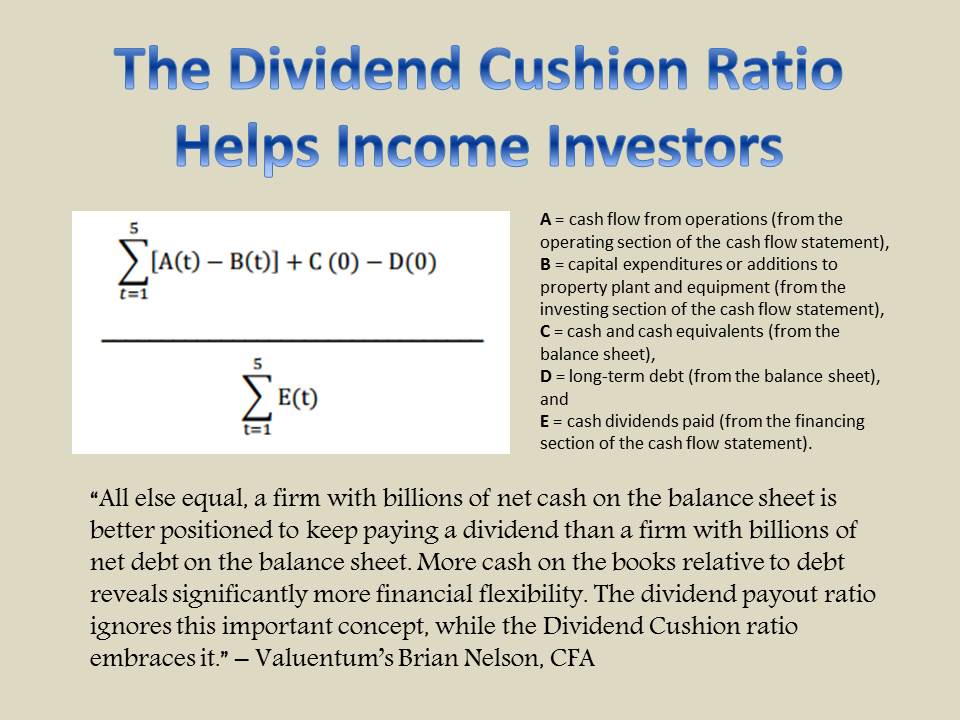Member LoginDividend CushionValue Trap |
Valuentum
Reports
Fundamental data is updated weekly, as of the prior weekend. Please download the Full Report and Dividend Report for
any changes.
Latest
Valuentum Commentary
Mar 21, 2020
Top Ten Dividend Growth Stocks to Consider Amid COVID-19
Image Shown: A look at some of the top dividend growth stocks to consider, companies with strong Dividend Cushion ratios and nice payout growth trajectories, in light of ongoing turbulence in equity markets. The 'Multiplier' column multiplies a company's dividend yield by its Dividend Cushion ratio. The novel coronavirus (‘COVID-19’) pandemic continues to wreak havoc on global economies, credit and equity markets, and the livelihoods of many. We sincerely hope everyone stays safe during this pandemic. US equities have sold off aggressively during the past month, with the S&P 500 down ~25% year-to-date as of this writing, punishing the names of several top quality dividend growth opportunities that we will highlight in this note today. Mar 19, 2020
Extreme Volatility and Crisis Economics
Image: The Dow Jones has now registered 8 consecutive trading days with a 4% move in either direction, from March 9 through March 18. This is the most volatile time in history, a streak that is longer than the 5 consecutive days registered in November 1929 (Great Depression), 4 consecutive days in 1987 (Crash of 1987), and 4 consecutive days in 2008 (Great Financial Crisis). The worst of the declines may still be ahead of us. The S&P 500 still is trading within our fair value estimate range of 2,350-2,750, and we wouldn’t be surprised to see panic/forced selling all the way down to 2,000 on the S&P. Expect more volatility, and please stay safe out there as the world declares all out war on COVID-19. Our best ideas remain in the Best Ideas Newsletter portfolio, Dividend Growth Newsletter portfolio, High Yield Dividend Newsletter portfolio, and Exclusive publication. Mar 18, 2020
US Considering $1 Trillion (Or More) Fiscal Stimulus Program
Image Source: Frank Boston. A lot has changed in a short period of time since we published our first note covering the potential for a major US fiscal stimulus program back on March 10. Due to the sheer amount of pummeling the stock and credit markets have taken over the past few weeks, along with consumer, business, and investor confidence at-large (we’ll get a better read on that over time), it seems that both Democrats and Republicans are now more open to a major fiscal stimulus program than before. The ‘Survey of Consumers’ conducted by the University of Michigan notes the ‘Index of Consumer Sentiment’ fell from 101.0 in February 2020 down to 95.9 in March 2020, and there’s room for that index to fall a lot further. Please note the next data release date is March 27. In all likelihood, this is all due to the negative impacts posed by the ongoing novel coronavirus (‘COVID-19’) pandemic to both the health of individuals (particularly the older demographics and those with preexisting conditions) and the health of the overall economy (due to the “cocooning” of households and consumers). We sincerely hope everyone, their loved ones, and their families stay safe out there as we get through this pandemic as a nation and as a global community. Mar 17, 2020
Top Ten Ideas for Consideration Amid COVID-19
Members only content. The novel coronavirus (‘COVID-19’) pandemic continues to sweep the world, and governments are shutting down business activity, driving most of the global economy to a screeching halt. In such an environment, we don’t think investors should go bottom-fishing on some of the worst businesses that have been beaten up the most during this crisis, but rather, we think this crisis is giving investors the opportunity to consider positions in some of the strongest companies out there. In this members-only article, we cover ten high quality, “moaty” names with strong balance sheets, capital-light operations, great shareholder value creation (attractive “castles’), and ones that have business models that we think can better withstand the novel coronavirus (‘COVID-19’) pandemic. What’s more, most of these companies are 20%-30% off their most recent pricing highs! Dig in. Mar 17, 2020
Oracle’s Strategic Shift is Starting to Bear Fruit
Image Source: Oracle Corporation – Third Quarter Fiscal 2020 Earnings Press Release. On March 12, Dividend Growth Newsletter portfolio holding Oracle Corp reported earnings for the third quarter of fiscal 2020 (period ended February 29, 2020) which handily beat consensus expectations on the both the top- and bottom-lines. Growing subscription revenues at its cloud-based businesses were key to generating this outperformance, and most importantly in our view, Oracle showcased that its outlook is improving as it shifts away from old and stale IT infrastructure offerings (i.e. enterprise data application management) and towards the IT infrastructure of the 21st Century (cloud-based services i.e. software-as-a-service and infrastructure-as-a-service). Shares of ORCL yield ~2.1% as of this writing and our fair value estimate stands at $55 per share. Mar 17, 2020
Buybacks and Wealth Destruction
From Value Trap: "According to S&P Dow Jones Indices, S&P 500 stock buybacks alone totaled $519.4 billion in 2017, $536.4 billion in 2016, and $572.2 billion in 2015. In 2018, announced buybacks hit $1.1 trillion. Given all the global wealth that has been accumulated through the 21st century, it may seem hard to believe that another Great Depression is even possible. However, in the event of a structural shock to the marketplace where aggregate enterprise values for companies are fundamentally reset lower, the vast amount of cash spent on buybacks would only make matters worse. The money that had been spent on buybacks could have been distributed to shareholders in the form of a dividend or even held on the books as a sanctuary of value within the enterprise during hardship. Buybacks, unlike dividends, can result in wealth destruction in a market economy, much like they can with companies. This is an important downside scenario that is often overlooked." -- Value Trap, published 2018 Mar 13, 2020
Dow Fell 9.99%, Worst Point Drop in History, More Nibbling?
Every stock in the S&P 500 fell during the trading session March 12, except one. The Dow Jones Industrial Average experienced the biggest point drop in history, Europe was crushed, gold and crypto-currencies sold off, Treasuries and munis were weak, as correlations among almost all asset classes approached one, as they often do during economic crises. Thursday, the S&P 500 closed at 2,480, near the low end of our 2,350-2,750 target range, and given the massive historical decline March 12 (the biggest point drop in history), equities are now starting to reflect a more neutral risk-reward balance at current levels, though we note downside risks remain. It may be time to consider doing some more nibbling on some of your favorite ideas. Where should you look? Our favorite ideas are always included in the Best Ideas Newsletter portfolio, Dividend Growth Newsletter portfolio, High Yield Dividend Newsletter portfolio and Exclusive publication. In particular, we think ideas that have strong net cash positions, strong economic returns ("castles"), solid moats around their operations (competitive advantages), and strong free cash flow generation are the places to look during crises. Mar 11, 2020
Seeds of Financial Crisis May Have Been Sown, Volatility Soars
Image Shown: The broader market indices continue to reveal tremendous levels of volatility. The Dow Jones Industrial Average dropped 5.86%, or 1,465 points, to 23,553 during the trading session March 11. From Value Trap: It seems like the markets experience a new financial crisis every decade or so. During the past few decades alone, there have been three significant banking crises: the savings and loan crisis of the late 1980s/early 1990s; the fall of Long-Term Capital Management and the Russian/Asian financial crisis of the late 1990s; and the Great Recession of the last decade that not only toppled Lehman Brothers, Bear Stearns, Washington Mutual, and Wachovia but also caused the seizure of Indy Mac, Fannie Mae and Freddie Mac...It's likely we will have another financial crisis at some point in the future, the magnitude and duration of which are the only questions. My primary reason for this view is not to be a doomsayer, but rests on the human emotions of greed and fear... -- Value Trap, published 2018 Mar 10, 2020
S&P 500 Hits Target Range, Nibbling at Ideas?
As we have outlined extensively in Value Trap: Theory of Universal Valuation, the combination of indexing and quantitative algorithmic trading is creating a situation of tremendous volatility. When indexers sell, they're not selling overpriced equities, they're selling everything in the index, indiscriminately. This has profound implications on the levels of broad market volatility, as we've been witnessing, exacerbated by the quants that pay little attention to fundamental analysis.
prev12345678910111213141516171819202122232425
26272829303132333435363738394041424344454647484950 51next Latest News and Media The High Yield Dividend Newsletter, Best Ideas
Newsletter, Dividend Growth Newsletter, Nelson Exclusive publication, and any reports, articles and content found on
this website are for information purposes only and should not be considered a solicitation to buy or sell any
security. The sources of the data used on this website are believed by Valuentum to be reliable, but the data’s
accuracy, completeness or interpretation cannot be guaranteed. Valuentum is not responsible for any errors or
omissions or for results obtained from the use of its newsletters, reports, commentary, or publications and accepts
no liability for how readers may choose to utilize the content. Valuentum is not a money manager, is not a
registered investment advisor and does not offer brokerage or investment banking services. Valuentum, its employees,
and affiliates may have long, short or derivative positions in the stock or stocks mentioned on this site.
|
|||||||||||||||||||||



Image: The Energy Select Sector SPDR and Financial Select Sector SPDR, two securities removed from both the Best Ideas Newsletter portfolio and Dividend Growth Newsletter portfolio in August 2019 have been ravaged during this market selloff. We maintain our view that the energy and banking sectors are worth avoiding during this market meltdown. The U.S. is stuck between a rock and a hard place, and we might get the next Great Depression regardless of what the Fed or Treasury does. The timeline for when these markets attempt to bounce back meaningfully from this disruption may not be based on whether COVID-19 cases roll over, but rather when consumers start coming out to spend in droves again, and that may not happen until we have a vaccine broadly available. We're maintaining our fair value range on the S&P 500 of 2,350-2,750, with expectations of panic/forced selling down to 2,000 on the broad market index (it closed at 2,304.92 on Friday, March 20). We believe that savvy investors have been nibbling at this market during the past couple weeks and may have achieved up to 50%-75% of their equity allocation in a well-diversified portfolio via dollar-cost averaging strategies, with expectations of further market declines. Our best ideas remain in the Best Ideas Newsletter portfolio, Dividend Growth Newsletter portfolio, High Yield Dividend Newsletter portfolio and Exclusive publication. Expect more gut-wrenching volatility.